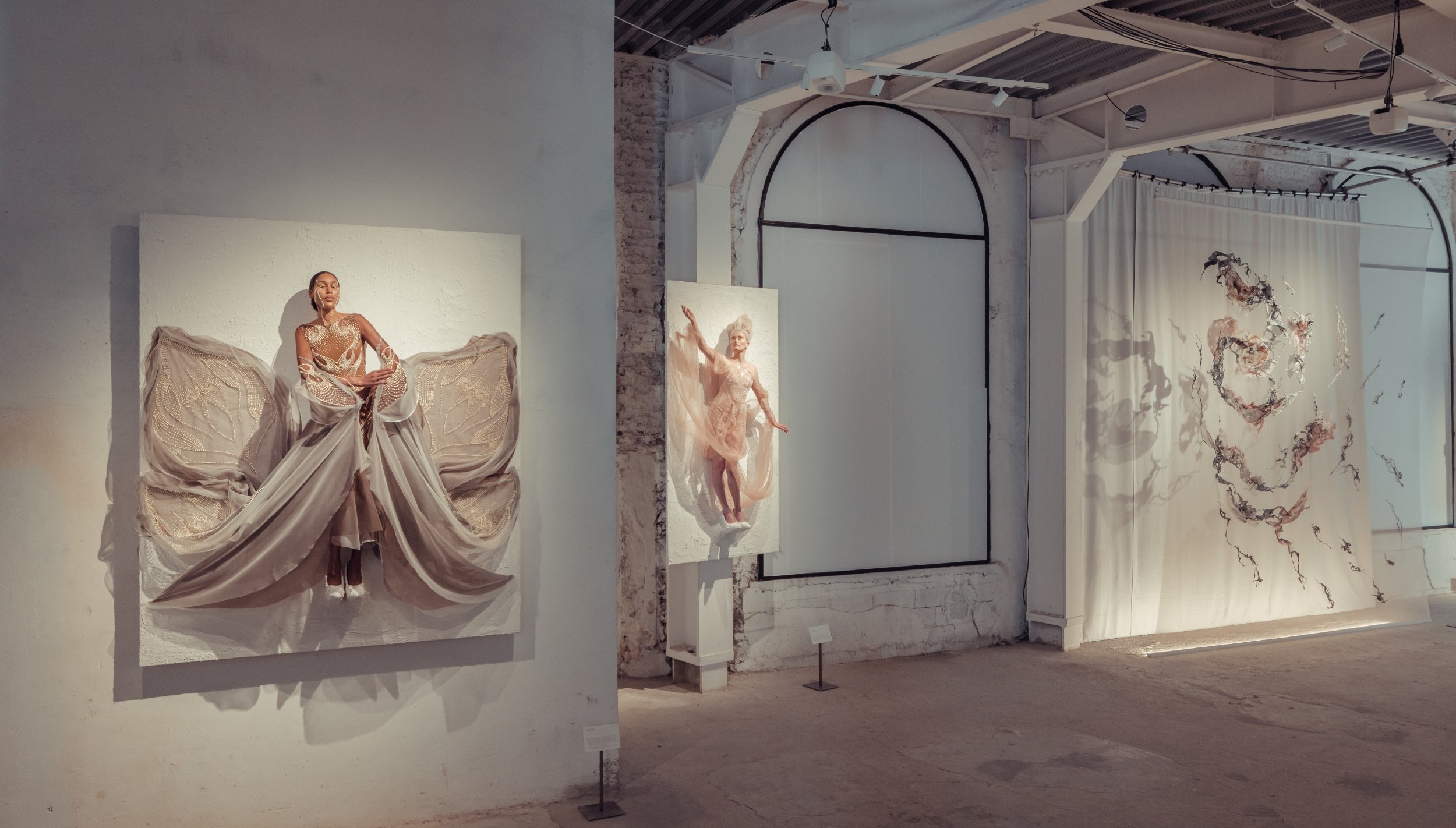
Ever wanted to wear a real work of art? The already blurred boundaries between art and fashion were further broken down yesterday morning during “Hybrid,” a show by Dutch designer Iris van Herpen at Paris Haute Couture Week.
Rather than your typical runway lapped by models, the designer’s “body sculptures” were worn by performers, or living pieces of art, who emerged out of an elevated plane in a manner reminiscent of the medieval statues that adorn cathedrals across the city. This installation was interspersed with four “aerial sculptures,” monumental yet subtle pieces with ethereal, twirling forms produced by applying paint, silk, and decorative 3D-printed elements onto suspended sheets of tulle.
Installation view of Iris van Herpen’s “Hybrid” presented at Paris High Couture Week in June 2024. Photo: © Frank Bohbot.
“This is quite new for me, to go away from the body,” said van Herpen ahead of the show. “I’ve always seen my body works as sculptures themselves and love working for the body. There are certain dynamics and transformations that I feel really inspired by.” The designer also learned classical ballet as a child, so it is intuitive for her to imagine form in motion.
“At the same time, I really like letting go of the scale and the space of the body,” added van Herpen. “But the aerial sculptures live in the same universe. I really feel there is a dialogue between them.”
Though the aerial works are static, they are suggestive of cyclonic movement. Unfolding Time resembles wisps of silvery smoke rising weightlessly from the floor while Embers of the Mind captures the whirling rhythms of the wind.
Iris van Herpen working on the aerial sculpture Embers of her Mind (2024). Photo: Melissa Shriek.
The whole spectacle lasted 45 minutes, much longer than the flash in the pan that is most fashion shows. “Couture pieces are experienced very briefly,” said van Herpen. “For me, there is also beauty to a longer duration of experiencing art.” After all, the aerial pieces took up to fourth months each to produce. “I really wanted to stretch my own perception of time in the creative process but also for the audience when they perceive the work.”
The new venture was inspired by the process of preparing for “Sculpting the Senses,” a recent retrospective of van Herpen’s work at the Musée des Arts Décoratifs in Paris. Looking back over 15 years spent producing unique pieces of couture with a contemporary feel for celebrities like Beyoncé, Lady Gaga, and Björk, her mind turned towards a latent artistic impulse that she felt had never been fully explored.
Detail of Iris van Herpen’s aerial sculpture Unfolding Time (2024) presented at Paris High Couture Week in June 2024. Photo: © Frank Bohbot.
“It wasn’t a quick decision,” said van Herpen. “I had these works in my mind already for a few years.” The designer has long been influenced by artists like the 16th-century Dutch painter Hieronymus Bosch as well as contemporary sculptors like David Altmejd, Antony Gormley, and Louise Bourgeois.
Of course, the transition from fashion designer to sculptor presented some challenges. For one thing, van Herpen’s couture atelier in Amsterdam was too small to contain her new practice so she opened a new studio in a disused office to the west of the city.
Installation view of Iris van Herpen’s “Hybrid” presented at Paris High Couture Week in June 2024. Photo: © Frank Bohbot.
“When I work on the couture pieces, I don’t sketch,” said van Herpen. “I always just do draping on the mannequin so it’s a very sculptural approach already. I need the three-dimensionality.” She often also uses transparent tulle in order to further emphasize the body. “It’s like an invisible skin,” she said. “I think you can look at the skin as a canvas by itself. The aerial sculptures are made from the same base.”
While van Herpen’s practice is known to be experimental in pioneering new techniques, she found working with such a delicate material on such a different scale required a new “trial and error” approach. “I started building up the layers, and I found that if I went in a certain direction the tulle would start pleating, for example,” she said. “That’s why it took a year to really find the right balance between the invisibility of it and the three-dimensionality.”